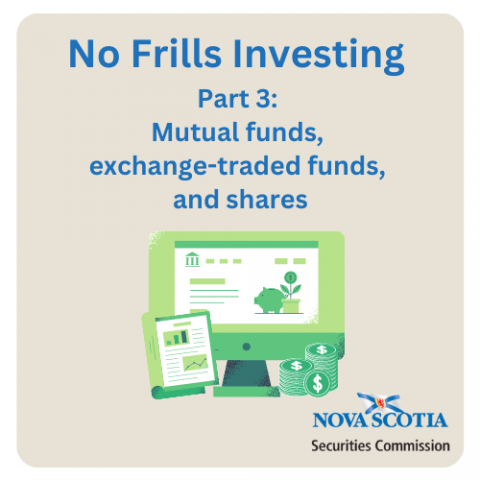Submitted by nsscadmin on

Our series on No Frills Investing concludes this week with a look at three basic investment products that you may be offered by a registered adviser, or that you may be interested in purchasing if you’re using a discount broker (also known as order execution only service). We’ll start out by describing each investment product and then break down the fees involved with each.
Mutual funds are a type of investment fund. Each mutual fund holds a collection of securities, such as bonds and/or stocks. A professional money manager manages the fund. When you purchase units in the fund, you receive a share of the fund’s profits and losses. Mutual funds are open-ended, which means as more people invest in the fund, the fund issues new units.
Exchange Traded Funds (ETFs) are similar to mutual funds in that they are also a type of investment fund that holds a collection of other securities. One major difference between a mutual fund and an ETF is that, as the name suggests, an ETF trades on an exchange. This means you can buy and sell units of an ETF throughout the day at a fluctuating trading price as long as the exchange is open. You can only buy or sell mutual fund units once a day, after markets close, when that day’s price is settled.
Shares, also commonly known as equities or stocks, are securities issued by companies to raise capital. The public can purchase these shares, which allows investors to own an equity stake in that company. This may allow the investor to share in the company’s profits if the company decides to share profits by issuing dividends. Equities can also be sold for a capital gain if the investor can sell them for a higher price than they purchased them. Like ETFs, shares of public companies typically trade on an exchange.
Now let’s talk about fees.
Mutual funds can have various fee structures. The ones that mutual fund investors will typically encounter include management expense ratios (MER), loads, and embedded commissions.
An MER consists of ongoing management fees paid to the fund manager, administrative costs deducted from the fund, as well as trailing commissions paid to your advisor or firm. The MER is reported as a percentage of the value of the fund and reduces your returns. Published historical returns of funds are calculated net (that is, after payment) of the MER.
The type of load fees you’ll pay are front end loads. A front end load is a commission paid to a mutual fund dealer at the time of purchase. This is calculated as a percentage of your initial purchase and typically ranges from 1 to 5 percent.
Embedded commissions, also known as trailing commissions, are paid as long as you hold the fund. These commissions are paid out of the fund to your adviser and/or their firm for the ongoing investment advice they provide. The amount of a trailing commission can vary, but typically is between 0.25 to 2 per cent, and is included in the fund’s MER.
ETFs have similar fees to mutual funds, including an MER. ETFs do not have loads but they may have a commission payable on their purchase and sale depending on which broker you use. ETFs typically have lower MER’s than mutual funds, but fees should not be the only consideration you look at when determining if an ETF, or which ETF, is right for you and your investment goals.
Shares do not have the same fees associated with mutual funds or ETFs. When you purchase and hold shares you won’t pay an MER or other fees. Like ETFs, you may be charged commissions or fees when purchasing or selling shares, depending on your broker.
Depending on your financial situation and your investing and financial goals, certain investments may be a better option for you than others. Make sure you know what securities best fit your situation and work with your adviser (if you have one) to develop a portfolio and investment strategy that works for you.
